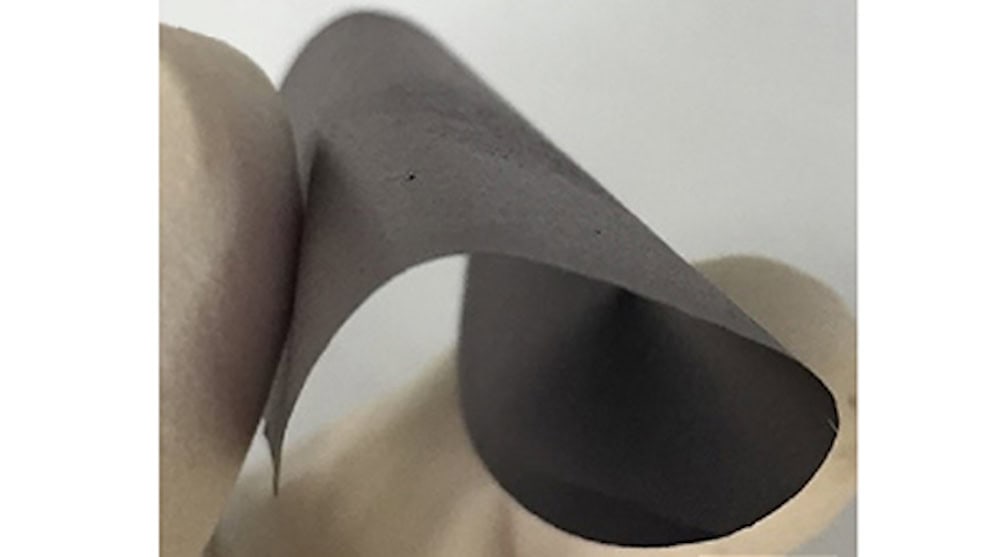
[Image above] Photograph of the flexible freestanding MXene film used as a barrier membrane in guided bone regeneration. Credit: Zhang et al., International Journal of Nanomedicine (CC BY-NC 3.0)
Here at CTT, we’ve discussed the potential of various ceramic and glass materials for treating bone, including clay-enhanced hydrogel, akermanite-based bioceramic structures, and phosphate glass. Now researchers are investigating the potential of another ceramic material to treat bone—MXenes.
MXenes are a family of 2D transition metal carbides, carbonitrides, and nitrides that show up regularly on CTT. I last covered them two months ago when reviewing their applications in water treatment and environmental remediation.
In that CTT, I mentioned a lot of research takes place on MXene applications in energy storage as well. Yet to date, research on MXenes in biomedical applications happens less frequently.
Current research on MXenes in the biomedical field
MXenes display several features that make them good candidate materials for biomedical applications, including high hydrophilicity, biocompatibility, biodegradability, and antibacterial activity.
Several studies recently explored MXene applications in biomedicine, including
- biosensing (e.g., 2015 and 2018),
- antibacterial materials (e.g., 2016 and 2017),
- bioimaging probes (e.g., 2016 and 2017), and
- cancer treatment (e.g., 2017).
However, there still are many unexplored areas of biomedicine in which MXenes have potential application. One such area is the focus of a recent open-access article published in the International Journal of Nanomedicine.
MXene films for guided bone regeneration
Jiebing Zhang, Yu Fu, and Anchun Mo from the State Key Laboratory of Oral Diseases at Sichuan University in China investigated using flexible freestanding titanium carbide (Ti3C2Tx) MXene films for guided bone regeneration (GBR).
GBR is a common technique used in dentistry to direct the growth of new bone. It works by using a barrier membrane to protect slower-growing cells that form bone from fast-growing fibrous connective tissues that try to fill the bone defect site.
Unsurprisingly, the membrane used for GBR is an essential component of the treatment. Desirable characteristics of the membrane include biocompatibility, cell-occlusion properties, integration by host tissues, and adequate mechanical and physical properties.

Schematic illustration of the principle of GBR. Credit: Elgali et al., European Journal of Oral Sciences (CC BY-NC-ND 4.0)
In the recent study, the researchers explain that due to good physiochemical performance, unique structure, and biological compatibility of 2D materials, “we hypothesize that MXenes are suitable for bone tissue engineering application and GBR treatment.”
To investigate GBR ability of Ti3C2Tx MXene films, the researchers performed in vitro studies on mouse preosteoblast cells to study cytocompatibility and osteoinductivity and in vivo studies on rats to study host tissue response.
In vitro results
“The majority of cells attached on the MXene films were alive, and only a few cells died … [which shows] that the Ti3C2Tx MXene films are not cytotoxic,” the researchers write. Additionally, the results indicated the films do not inhibit cell proliferation.
In vivo results
Films implanted subcutaneously (under the skin) exhibited no noticeable inflammatory cell infiltration nor necrosis, and macrophages were found attached to the MXene films, meaning “Ti3C2Tx are highly biocompatible with a good biodegradation profile,” the researchers conclude.
The researchers also explored GBR in vivo using a rat calvarial defect model, i.e., they implanted MXene films in rat skulls. Analysis of the films 4 and 8 weeks after surgery revealed “uniform and continuous new bone almost completely healed the bone defects.” However, it also revealed the mechanical strength of the films decreased in the body fluid environment, which “may be as a result of [the film] being redispersed and degraded in the body.”
In the conclusion, the researchers note these findings collectively provide evidence that Ti3C2Tx MXene films show promise in GBR therapy. They now plan to improve the mechanical properties of such films by developing a composite based on Ti3C2Tx MXene.
The open-access paper, published in International Journal of Nanomedicine, is “Multilayered titanium carbide MXene film for guided bone regeneration” (DOI: 10.2147/IJN.S227830).
Author
Lisa McDonald
CTT Categories
- Biomaterials & Medical
- Material Innovations
- Nanomaterials


